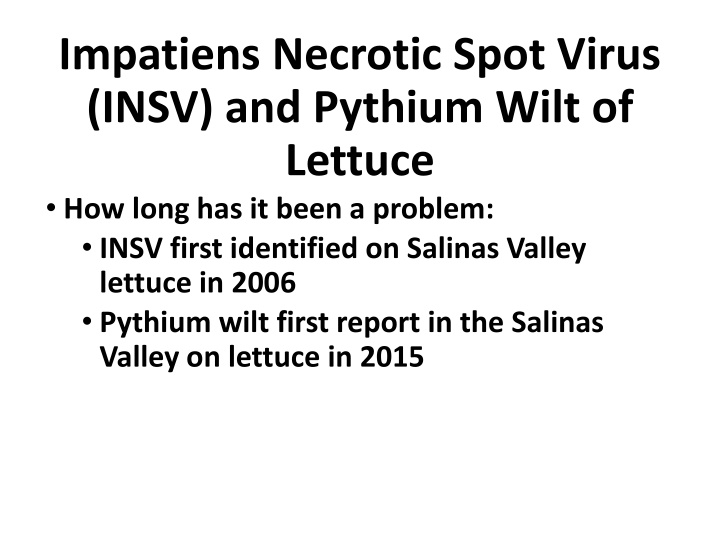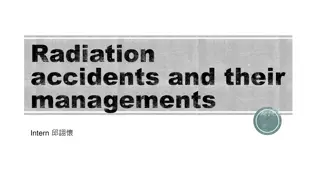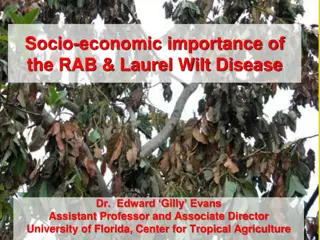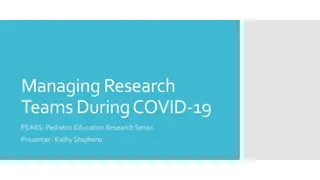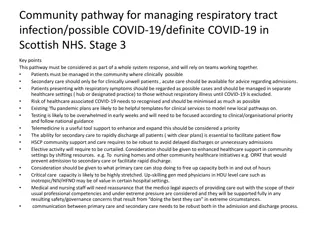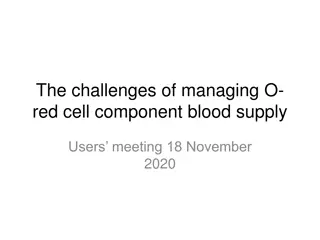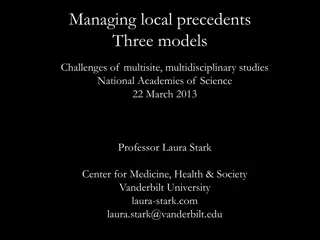Challenges in Managing INSV and Pythium Wilt
Impatiens Necrotic Spot Virus (INSV) and Pythium Wilt are significant issues affecting lettuce crops in the Salinas Valley. The diseases have escalated in severity, leading to economic losses. Control options, such as addressing weed hosts and researching effective fungicide applications, are being explored to mitigate the impact. Continued research is essential to develop sustainable management strategies for these challenging diseases.
Download Presentation

Please find below an Image/Link to download the presentation.
The content on the website is provided AS IS for your information and personal use only. It may not be sold, licensed, or shared on other websites without obtaining consent from the author.If you encounter any issues during the download, it is possible that the publisher has removed the file from their server.
You are allowed to download the files provided on this website for personal or commercial use, subject to the condition that they are used lawfully. All files are the property of their respective owners.
The content on the website is provided AS IS for your information and personal use only. It may not be sold, licensed, or shared on other websites without obtaining consent from the author.
E N D
Presentation Transcript
Impatiens Necrotic Spot Virus (INSV) and Pythium Wilt of Lettuce How long has it been a problem: INSV first identified on Salinas Valley lettuce in 2006 Pythium wilt first report in the Salinas Valley on lettuce in 2015
Impatiens Necrotic Spot Virus (INSV) and Pythium Wilt of Lettuce In 2020 incidence and severity of both of these diseases increased to unprecedented and catastrophic levels Could have been related to two heat spells Although, we have had heat spells in the past and not seen these diseases flair up 2021 elevated levels of these disease continued, but may have been less due to cooler weather conditions this is unclear
INSV Symptoms Necrosis on romaine Internal Necrosis
Pythium Wilt Symptoms Outer leaves die back Rotting of tap root Loss of lettuce stand
Control Options for INSV It is spread by an insect, thrips which complicates control They are a small insect easily blown long distances by the wind They are difficult to control in conventional production Applied for a 24c for Torac but was denied Organic production in Salinas Valley valued at $757 million Very limited control options for organic
Control Options for INSV Controlling weed hosts for this virus in the winter months to break the disease cycle is a key practice Growers have organized and formed a task force to address weed issues Working with CalTrans to address weeds on the 101 corridor Educating growers on the need for fastidious weed control on farms and surrounding areas
Control Options for Pythium Wilt We have been researching methods for controlling this disease Fungicide control has been limited due to difficulties of getting the fungicide to all parts of the root system
Research Needs Continued research is needed Better understand the epidemiology and biology of these diseases to identify ways to mitigate their impact Direct control methods such as use of pesticides and biologicals Better understanding of cultural control methods Varietal resistance
